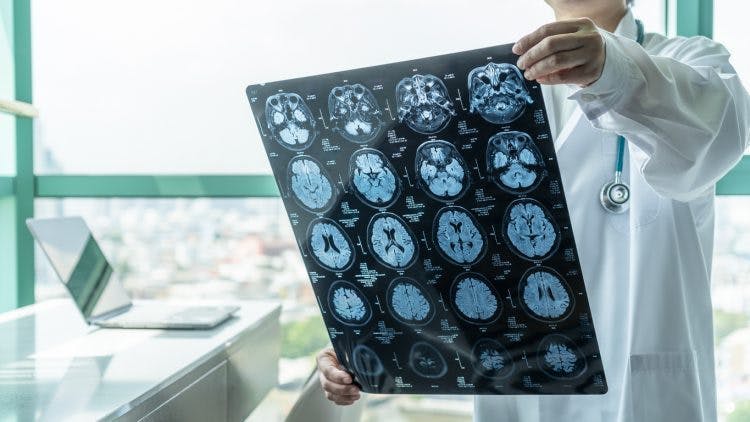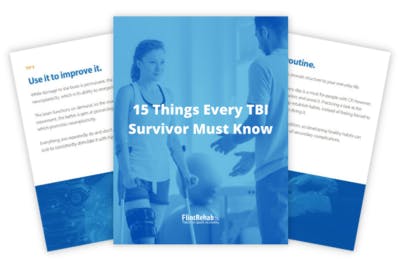No products in the cart.
No products in the cart.
No products in the cart.
No products in the cart.
Home » Neurological Recovery Blog » Traumatic Brain Injury » Focal Brain Injury: Understanding the Causes, Symptoms, & Treatments
Last updated on November 9, 2022

Traumatic brain injury is generally classified into two categories: focal and diffuse. A diffuse brain injury affects multiple areas of the brain, whereas a focal brain injury refers to a single area of localized damage.
Focal brain damage can lead to a variety of secondary effects, depending on the severity and location of injury. Fortunately, many of these effects can be improved with a combination of treatments, which often includes a rigorous rehabilitation program.
To help you better understand this condition, this article will discuss the causes, symptoms, and treatments for a focal brain injury.
Use the jump links below to help you navigate through this article:
A traumatic brain injury is a broad term used to define a wide range of injuries or damage to the brain. Injuries can be focal, meaning they are confined to only one area of the brain, or they can be diffuse, which means the damage affects more than one area of the brain. In some cases, injuries can be both focal and diffuse, depending on the cause.
Some of the most common causes of focal brain injury include:
Focal brain injury can occur at the site of impact or on the opposite side of the impact, depending on how the injury is sustained. When focal brain injury occurs on both sides (site of impact and the opposite side) it is called a coup-contrecoup injury, meaning “blow and counterblow”.
Focal brain injury can be classified into two main categories: open (penetrating) and closed. Open injuries refer to head trauma where the skull is fractured or penetrated. Closed injuries, however, do not involve skull fractures and are far more common.
Additionally, focal brain injury can be further classified into different categories based on the type of hemorrhage or bleeding caused.
Focal brain injury hemorrhages can include:
Bleeding in the brain can increase the risk of complications and be life-threatening; therefore, timely treatment is crucial. Treatment will depend on the severity and the cause of the focal brain injury. For example, when a TBI is severe, surgery may be required to help relieve pressure from the brain and reduce bleeding or further damage.
Symptoms of focal brain injury vary depending on the area of the brain affected. One region of the brain can control multiple functions. Therefore, even if only one area of the brain was directly impacted, a survivor may experience multiple different secondary effects or deficits.
For example, the frontal lobe is a large part of the brain that plays a role in behavior, language, and movement. When an individual sustains a frontal lobe injury, they may experience a combination of symptoms such as difficulty with speech and language or loss of voluntary movement.
Other symptoms of a focal brain injury can include:
While all symptoms of focal brain injury require urgent medical care, some symptoms may signal a life-threatening hematoma, a collection of blood on the brain. One type, a subdural hematoma, can occur from both diffuse and focal brain injury and requires immediate medical intervention.
For example, during a car accident the initial blow to the head may only cause focal damage. However, other secondary injuries such as oxygen deprivation caused by a hematoma can lead to more widespread damage throughout the brain. Studies show that brain inflammation after TBI is not only restricted to focal lesions, but can also spread to remote areas of the brain and persist for weeks or even months following the injury.
Therefore, all symptoms of a TBI should be taken seriously and medical treatment should be sought out as soon as possible.
Initial treatment of focal brain injury will involve monitoring and stabilizing the individual to ensure no life-threatening complications develop. For example, if there is swelling in the brain, doctors may need to perform emergency surgery to relieve the pressure.
In severe cases, focal brain injury may require a decompressive craniotomy. This type of surgery involves removing a bone flap (a portion of the skull) in order to access the brain underneath. Once treated, the bone flap is reattached to the skull with metal plates and screws.
In other cases, a craniectomy may be required. Unlike a craniotomy, the bone flap is not immediately replaced after surgery in order to allow pressure on the brain to continue to resolve. Instead, individuals are required to wear a helmet to provide protection to the brain until the bone flap is replaced, usually around 6 weeks after the initial surgery.
While both types of surgery can be helpful, there is a rare complication after removing a piece of the skull known as “Syndrome of the Trephined.” This syndrome is associated with sensorimotor deficits and neurological deterioration.
Symptoms of Syndrome of the Trephined can often include:
There may also be other motor, cognitive, and language deficits associated with Syndrome of the Trephined. While this is a rare complication of decompressive surgery, all symptoms should be taken seriously. Doctors can provide survivors with more information regarding surgical interventions and other potential treatments for focal injury.
After discharge from the hospital, treatment may include a combination of rehabilitation therapies to help manage any potential secondary effects from focal brain injury. This can include physical, cognitive, emotional, and/or behavioral effects, depending on the area(s) of the brain affected.
Rehabilitation is a key part of TBI recovery because it helps stimulate the brain and activate neuroplasticity – the brain’s ability to naturally heal and rewire itself. Neuroplasticity works by strengthening existing neural connections and creating new ones for a specific skill. It is best activated by massed practice of rehabilitation exercises, meaning high repetition is extremely important for recovery.
The more a skill is practiced, the more the brain will recognize that skill and strengthen its neural connections, which can help restore communication between the brain and the affected muscles.
Therefore, it’s important to practice high repetition of exercises and activities during all aspects of a rehabilitation plan, which can include:
Every focal brain injury is different, and every person’s recovery process will vary. Usually, the stronger the rehabilitation regimen, the higher the chances of improving function and lowering the risk of further complications. Therefore, establishing a proper rehabilitation plan is essential for TBI recovery.
Focal brain injury affects only one region of the brain, unlike a diffuse injury that affects multiple areas. However, depending on where the focal brain injury occurred, survivors may experience a wide range of secondary effects including physical, cognitive, and emotional effects.
Fortunately, these effects can be managed with a proper rehabilitation program to help stimulate the brain and activate neuroplasticity. There are also other treatments available to help minimize the risk of complications after a TBI. Consult your doctor to obtain a unique recovery plan that is safe and effective for your specific condition. We hope this article helped you understand the causes, symptoms, and potential treatments for focal brain injury.

If you like our content, you’ll love our ebook and newsletters! Get instant access to our TBI recovery tips ebook with 20 pages of helpful advice by signing up below.
You’ll also receive our emails that share survivor stories and more useful TBI recovery tips, which you can opt out of at any time. (We know you’ll love them, too.)
We will never sell your email address, and we never spam. That we promise.


Time with a speech therapist is extremely valuable during recovery, especially if you struggle with communication, critical thinking, or memory after brain injury. Insurance typically covers speech therapy for a fixed amount of time. But once it’s over, recovery is in your hands.
That’s why a team of neuroscientists and clinicians from Boston University created the CT Speech & Cognitive Therapy app. Designed for those recovering from stroke, TBI, or living with neurological conditions, the app contains over 100,000 cognitive exercises that are all available right from your phone or tablet. That’s like having a speech therapist by your side whenever you want!
This app is the perfect fit if you want to improve your speaking, memory, or general mental sharpness. And, it’s affordable at just $29.99/month!
“For the past 6 months, my son has used the app about three times a week. The app is like a virtual therapist, it’s very easy to use, and it gives him immediate feedback.
He now understands things faster, can make decisions with less hesitation, has improved recognition of words, and his confidence is higher. I also find it easy to get in touch with customer service; they pleasantly help out. The whole experience has been great.”
— Miriam
With the CT App, you can get the guidance you need right from your phone or tablet. You can use it on your own or in between sessions with your speech therapist.
Whether you struggle with aphasia, memory loss, or critical thinking, the CT Speech & Cognitive Therapy App can help.
“The CT app has helped me gather my confidence by building on and reinforcing old forgotten skills. It helps to see my percentages increase, and work harder when they decrease. It’s very self-motivating.” -Kathryn
We are confident that this app will help improve your speech and cognitive function after brain injury. Like our recovery tools, the CT App is also covered by our 30-day money-back guarantee.

Do you know these 15 TBI recovery tips?
Get a free copy of our ebook 15 Things Every TBI Survivor Must Know. Click here to get instant access.
Grab a free rehab exercise ebook!
Sign up to receive a free PDF ebook with recovery exercises for stroke, traumatic brain injury, or spinal cord injury below: